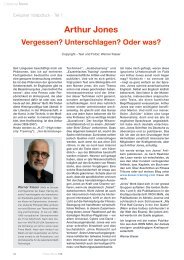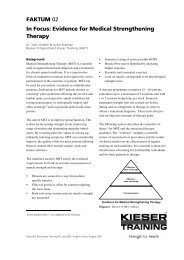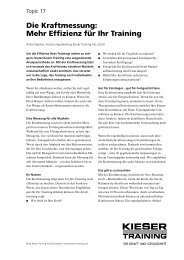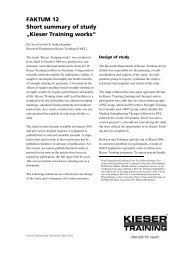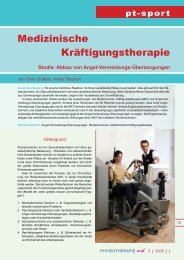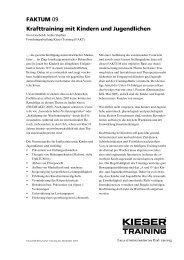Study: Strength training for chronic back pain - Kieser Training
Study: Strength training for chronic back pain - Kieser Training
Study: Strength training for chronic back pain - Kieser Training
You also want an ePaper? Increase the reach of your titles
YUMPU automatically turns print PDFs into web optimized ePapers that Google loves.
OrIGINALIA STrENGTh TrAINING fOr ChrONIC BACk PAIN<br />
Table 3: Results of repeat measurements<br />
3 months<br />
Intensity of <strong>pain</strong> in last 4<br />
weeks (0-100)<br />
and avoiding a recurrence. If there is a recurrence, the improved<br />
structural and functional quality of muscles means that function is<br />
likely to be restored more quickly.<br />
The time directly spent on <strong>training</strong> was only 3 hours per<br />
month; over the 6-month period, it was 18 hours. The independent<br />
machine-based <strong>training</strong> was well received by participants. The<br />
drop-out rate was 27%, which is less than the comparable figure<br />
from German fitness chains (35.3%) [1]. For those <strong>training</strong> at home,<br />
it is assumed that the drop-out rate would be significantly higher<br />
and the quality of the <strong>training</strong> insufficient [16].<br />
Anika Stephan and Dr. Sven Goebel work <strong>for</strong> the Research and<br />
Development Department at <strong>Kieser</strong> <strong>Training</strong> AG. Prof. Dr. Dietmar<br />
Schmidtbleicher has been remunerated <strong>for</strong> his consultancy by <strong>Kieser</strong><br />
<strong>Training</strong> AG.<br />
BIBLIOGrAPhy<br />
<strong>Training</strong> group (n=58) Control group (n=16)<br />
mean ±SD Confidence interval median Z D mean ±SD Confidence interval median Z d<br />
15 ±15.15 ** [10.98;19.02] 15 -4.132 -0.56 16.25 ±10.25 [10.79;21.71] 15 -1.427 -0.33<br />
Pain Severity (PS. 0-100) 72.68 ±20.28 ** [67.30;78.06] 71 -4.800 0.87 68.13 ±17.65 [58.72;77.53] 62 -1.863 0.69<br />
Effects of Pain (EP.<br />
0-100)<br />
Oswestry Disability Index<br />
(ODI. 0-100)<br />
6 months<br />
Intensity of <strong>pain</strong> in last 4<br />
weeks (0-100)<br />
86.42 ±15.64 ** [82.27;90.57] 91.7 -3.981 0.68 83.07 ±16.42 [74.32;91.82] 89.6 -1.907 0.71<br />
5.10 ±6.66 ** [3.33;6.87] 2 -4.642 -0.65 4.83 ±6.80 * [1.20;8.45] 2.1 -2.308 -0.60<br />
14.57 ±16.66 ** [10.19;18.95] 10 -4.449 -0.55 14.69 ±15.76 [6.29;23.08] 10 -1.576 -0.33<br />
Pain Severity (PS. 0-100) 75.71 ±23.03 ** [69.01;81.12] 76 -5.034 0.94 74.69 ±23.60 * [62.11;87.26] 73 -2.224 0.84<br />
Effects of Pain (EP.<br />
0-100)<br />
Oswestry Disability Index<br />
(ODI. 0-100)<br />
Lumbar extension<br />
strength (Nm)<br />
87.43 ±18.16 ** [82.65;92.20] 93.8 -3.595 0.69 83.07 ±26.50 [68.95;97.20] 95.8 -1.637 0.54<br />
4.10 ±7.98 ** [1.99;6.22] 0 -4.738 -0.71 6.97 ±12.45 [0.33;13.60] 1 -1.084 -0.21<br />
247.11 ±97.8 * [219.61;274.62] 211.89 -3.412 0.25 193.99 ±72.35 [145.38;242.59] 163.86 -0.622 0.04<br />
Wilcoxon non-parametric signed rank test as a comparison of start of intervention: ** p





